
Terre Haute - A history and a guide
This is my history and guide to my adopted home - Terre Haute, Indiana.
Indians of Indiana
This is not a history of any particular tribe but of Indiana. From first contact with the white man and their relentless move westward, pushing the Native Americans before them, from about 1650 onwards many tribes lived for a while in Indiana. The story of Indiana between 1750 and 1840 is the story of what happens when two very different cultures meet.
The Delaware belong to the Algonquian speaking peoples. Their own name is the Lenape, which means "original people" or "true men". Amongst other tribes they were called the "Grandfather" tribe as they are believed to have been the original tribe of the Algonquian speakers. They were respected as peacemakers and often served to settle disputes among the tribes. Sir Thomas West, Lord De la Warr (1577 - 1618) was appointed governor of Virginia in 1609. He left England in April 1610 to take up his new post in America where he found the settlers in Jamestown disillusioned with colonial life and ready to return home. He sent Sir Samuel Argall to look for supplies. Argall, sailing North, found and named one of the bays De la Warr in honour of his governor. Later, the name was also given to the river, changed to Delaware and became of the name of the Indians living there. The Delaware, whose home territory was in what is now Delaware, Pennsylvania, New Jersey and New York states, were amongst the first Indians to have contact with the European settlers. After living in this territory for thousands of years it wasn't long before they moved, or were forced to move westward.
The Kickapoo also belong to the Alogonquian speaking people. They take their name from Kiwegapawa, which means "he stands about" or "he moves about". The Kickapoo homeland was originally in northwest Ohio and southern Michigan in the area between Lake Eerie and Lake Michigan. By 1658 attacks from the east by the Ottawa, Neutral and Iroquois Indians had forced them into southwest Wisconsin. Around 1700 they had begun to move south into central Illinois and the Wabash Valley in Indiana.
The Miami are also an Alogonquian speaking nation. Their original homeland was northern Indiana, north eastern Illinois and north western Ohio. The Wea and Piankashaw are part of the Miami nation but were forced from the area by the Iroquois in the 1650's. They settled in Wisconsin and northern Illinois but by around 1710 had mostly returned to Indiana. Their name, Me-ah-me (whence Maumee), and in the full plural form Ou-miami-wek, is of uncertain meaning and derivation. Early English writers called them Twightwee, a corruption of their Iroquois name, intended to imitate the cry of a crane. The first European contact was recorded as being about 1654 when two French explorers found some Miami refugees northwest of Green Bay, Wisconsin. The first written record of them was in 1658.
The Potawatomi are another Aloginquian speaking nation. Their name means "people of the fire-place" or "the fire keepers. Their original homeland was north of the Great Lakes. Their first contact with the white man was with the French explorer Jean Nicolet around 1634. By around 1700 they had moved to the area which is now Chicago, a hundred years after that they had moved further south into Illinois and Indiana.
The Shawnee consider themselves as descendants of the Delaware and so are another Aloginquian speaking nation. Their name is derived from Shawun which means Southerner. Their original homelands were in Ohio, Pennsylvania and West Virginia. Disputes with the Iroquois in the late 17th century forced them into South Carolina and Illinois. Their first contact with the white man was with the British in South Carolina in 1674.
The Wyandot whose name means "dwellers on a peninsula" or "islanders", are also known as Hurons which is derived from the French for rough. They are an Iroquoian speaking nation. Their original homeland was in Ontario, north of Lake Superior east along the St. Lawrence river valley in southern Quebec. When the French explorer Jacques Cartier first came across them in 1543 two of their villages were at Stadacona (Quebec) and Hochelaga (Montreal). Fighting with the Iroquois by 1650 had forced them to two locations, one near Quebec and another band near Detroit.
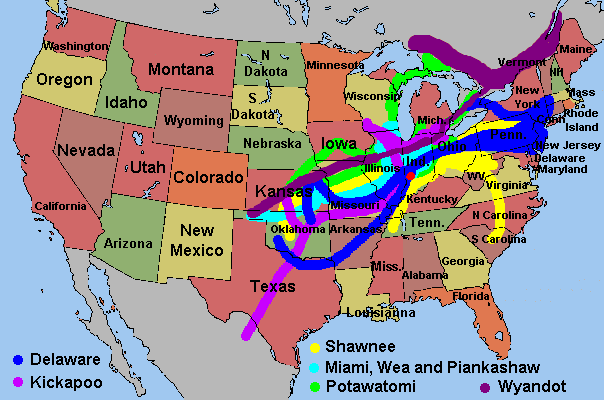
Native American movement across the US
Thanks to Dionicio Ontiveros for helping to make this map more accurate. He says that the Kickapoo were given land by the Mexican government at Nacimiento De Los Negros, Coahuila, Mexico. This is the official home of the Mexican Kickapu and the birthplace of his great-grandmother. She was born there in the mid-1800s, soon after their arrival there.
When I started researching this site I was under the misapprehension that when the histories mentioned Ohio they were referring to the state, this isn't the case as they are discussing Ohio Territory. At the period of time I am writing about here Ohio Territory covered not only the state of Ohio, but Indiana and parts of Illinois too. Where possible I've put the nearest modern day place name in brackets after the name they were known as at the time.
Around 1660 the Iroquois swept the tribes from the Ohio Valley. This huge tract of land included Indiana, Kentucky, Lower Michigan, Ohio, western Pennsylvania and West Virginia. The Iroquois didn't inhabit this land, preferring to keep their villages to their homeland in New York state but they kept the entire area as a sort of giant hunting preserve. Small bands from other tribes sometimes hunted in the area but no permanent villages were allowed until around 1730 a period of 70 years.
Between 1718 and 1736 the populations of the Illinois and Miami Indians were decimated by a series of epidemics. The Kickapoo took advantage of this to move south from Wisconsin to Illinois and Indiana.
In May, 1765 the British sent George Groghan to take control of the country settled by the Illinois. The force was attacked near the Wabash River by Kickapoo and Mascouten warriors. During the fighting Groghan was captured and three Shawnee chiefs who were among Groghan's escort were killed. A war with the Shawnee over the killing of the chiefs was narrowly diverted. Groghan was turned over to the Miami at Fort Ouiatenon, (now Layfayette), Indiana.
By 1765 the Delaware were in Ohio. In 1768, the Iroquois at Fort Stanwix, Ohio ceded Ohio and Kentucky to the British. This started fighting between the Connecticut and Pennsylvania militias over the land. The Shawnee tried to create an alliance of the Great Lakes and Ohio Valley tribes, including the Cherokee and Chickasaw, in 1770. This failed and with William Johnson, the British Indian agent, threatening war against the Iroquois to keep them quiet, the Delaware, Shawnee and Mingo had to face the settlers alone. The British managed to keep the Kickapoo and Miami living near the Wabash quiet by invalidating the claims of Wabash Land Company to their land. The Delaware knew what was coming and in the same year got permission from the Miami to settle in Indiana. By 1774 there were 50,000 white settlers west of the Appalachians, the range of mountains that stretch 1,600 miles from Quebec to Georgia.
The British and Americans had for several years been using the various Indian tribes as pawns in Ohio during the War of Independence. The Delaware, Kickapoo and Miami tried to remain neutral, but were eventually forced into fighting. In 1783 the remaining Delaware villages in east central Ohio were vulnerable and they moved to the northwest of the state and to southern Indiana. Some moved to settle in Louisiana, Missouri, and Texas. The same year the western alliance was formed, it came to include the Cherokee, Chickamauga, Delaware, Fox, Iroquois, Kickapoo, Miami, Ojibwe, Ottawa, Potawatomi, Sauk, Shawnee and Wyandot.
There were now around 12,000 American settlers north of the Ohio river. In 1785, the Chippewa, Delaware, Ottawa and Wyandot signed the Treaty of Fort McIntosh in Ohio. Most of the Delaware did not want this treaty and in the spring of 1786 Kickapoo and Miami warriors attacked American settlements along the lower Wabash in southern Indiana. There were now around 400 Americans living among the French on the Wabash and around 400 to 700 Kickapoo and Miami warriors arrived at Vincennes, threatening to kill all the Americans. The French arranged a truce and the Americans sent to Kentucky for help. That autumn George Rogers Clark arrived at Vincennes with his force of 175 Kentucky militia. Clark was offered help by the Kaskaskia, Kickapoo, Illinois, Miami and Piankashaw but refused. When he took Fort Sackville (Vincennes, Indiana) the British and French were spared, but the Indians there were massacred - and not by shooting. This turned the Indians in the area against the Americans. Henry Hamilton, the British commander of the fort, was known as the "Hair Buyer" from his habit of paying the Indians for the scalps of Americans.
The Shawnee started raiding parts of Ohio and Benjamin Logan and his Kentucky militia, who had arrived with Clark, retaliated with an attack against Shawnee villages in the south of the state. In December, the American governor Arthur St. Clair asked the alliance for a meeting at Fort Harmar (near Marietta, Ohio). The Delaware, Detroit, Potawatomi and Wyandot tribes decided to attend. In July, 1788 soldiers building the council house for the meeting were attacked by an Ottawa / Ojibwe war party, and 300 Kickapoo warriors ambushed an army convoy on the Wabash. The Treaty of Fort Harmar, signed in January 1789, was worthless.
In the summer, after Patrick Brown and his Kentucky militia attacked the Wabash villages, which were mainly Kickapoo and Miami, the Shawnee and Miami managed to persuade the Alliance to prepare for war under the leadership of the Miami war chief, Little Turtle. The Americans decided to resolve the matter with force and Little Turtles War last four years, from 1790 to 1794. Major John Hamtramck led raids against Indian villages along the Wabash but in October, 1790 Josiah Harmar's army of militia was ambushed on the upper Wabash with more than 200 casualties. The alliance had it's greatest victory in 1791 when they killed 600 and wounded 400 of Arthur St. Clair's army in western Ohio. Fort Recovery was later erected on the site of the battle. During General Charles Scott's offensive, Colonel John Hardin captured 52 Indian women and children. These he held in Kentucky and in 1792 the Wabash tribes (Illinois, Kickapoo, Piankashaw and Potawatomi) made peace with the Americans. The Fox and Sauk left the alliance as it was having trouble feeding its warriors.
In 1792, the Shawnee killed two of the American representatives on their way to meet with the alliance council. The following year, however, the Delaware protected the American delegation because it included Hendrick Aupamut, a Stockbridge (Mahican), with many Delaware relatives. The peace negotiations that summer failed, and in October, Wayne began his advance into northwest Ohio. Colonel "Mad" Anthony Wayne had been sent by President Washington to keep the peace between the Indians and the settlers. By now the British had decided to stop it's support of the alliance. In 1793 Wayne built Fort Recovery on the site of St. Clair's defeat, two years before. After a Shawnee attack on Fort Recovery failed to stop Wayne, a council was held on the banks of the Maumee. Only the Miami, Shawnee and Wyandot favored war, but there were now fewer than 800 warriors in the alliance. Even the Miami war chief Little Turtle was beginning to think the alliance would lose and urged negotiations. He was replaced by the Shawnee Blue Jacket, and on August 20th 1794, the alliance was defeated at the Battle of Fallen Timbers (north of Fort Greeneville). To avoid a fight with Wayne's army, the British at Fort Miamis (near Maumee, Ohio) closed their gates to the retreating warriors.
Wayne weakened the alliance, both morally and physically, by burning their villages and destroying their food. In October he destroyed the Miami villages on the upper Wabash and built Fort Wayne as a symbol of American authority in northeastern Indiana. In August 1795 the alliance signed the Fort Greenville Treaty and ceding the whole of Ohio except for the northwest corner. Not having any land in Ohio the Potawatomi didn't cede any of their land but still received $1,000 for signing the treaty. Fort Greenville was about 6 miles east of Fort Jefferson. Sixty of the 240 Potawatomi that attended the treaty signing got sick and died, this caused the British to accuse the Americans of poisoning them. This was never proved but it helped the cause of Tecumseh who was building an alliance against the Americans. The Delaware were now without any land of their own and most of them left for White River in the Miami land of east central Indiana, near to where Muncie is today. The only Delaware left in Ohio were Captain Pipe's small band on the upper Sandusky. It was about this time that the last of Mascouten were absorbed into the Kickapoo. The Delaware villages in south Indiana were now in the way of further American expansion. The Delaware went into a serious decline, men refused to work and alcohol abuse became serious. In 1801 the Shawnee chief Blue Jacket tried, and failed, to resurrect the alliance at Brownstown (near present day Detroit). The Potawatomi and others signed treaties at Fort Wayne (1803), Fort Industry (1805), and Grouseland (1805), ceding portions of Ohio, Indiana, and Illinois, but it was at the Detroit treaty signed in November, 1807 ceding the southeast quarter of lower Michigan where the Potawatomi for the first time were required to surrender some of their own land. The Moravians opened a mission but this closed in 1806.
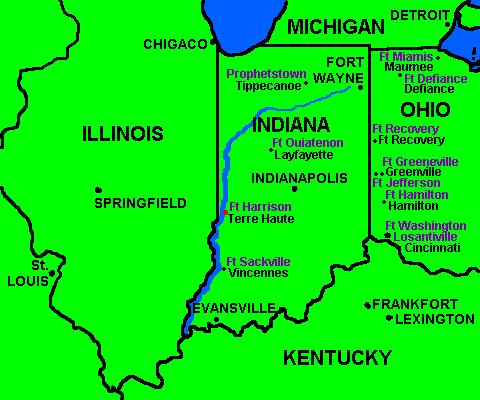
Some of the places in the text
The old names are in purple - their modern equivalents are in black
Other places mentioned but not on the map are:-
Coshocton - Coshocton, Ohio
Fort Dearborn - Chicago, Illinois
Fort Duquense later Fort Pitt - Pittsburgh, Ohio
Fort Harmar - Marietta, Ohio
Fort Henry - Wheeling, West Virginia
Fort Laurens - Bolivar, Ohio
Fort Malden - Amherstburg, Ontario
Fort Meigs - Perrysburg, Ohio
Fort Necessity - Irwin, Ohio
Fort Nelson - Louisville, Ohio
Fort Pontchartrain - Detroit, Michigan
Fort Sandusky - Sandusky, Ohio
Fort Stanwix - New York, New York
Fort Steuben - Steubenville, Ohio
Fort William Henry - New York, New York
Gnadenhutten - Gnadenhutten,Ohio
Pickawillany - Piqua, Ohio
Schoenbrunn - New Philadelphia, Ohio
The leading chief of the Delaware was Tetepachksit of the Turtle Clan. As a "peace chief," he was responsible for dealing with the Americans and therefore was often in danger of being killed by his own people. In 1803 the Delaware ceded part of their land in southern Indiana, the Miami still owned this land and were resentful. A second treaty was needed in 1806 to resolve this. In 1805 a Shawnee named, depending on which history you read, Lalawethika, Lauliwasikau or Laulawasikaw ("Loud Voice"), received a vision after which he changed his name to Tenskwatawa (the Open Door). He was also known by the Americans as "The Phophet". He urged the rejection of the white man's trade goods (especially liquor) and a return to traditional native culture and values, anyone disagreeing with Tenskwatawa was killed as a witch or traitor. Many of the Native Americans turned against him for this, but in 1806 he correctly predicted an eclipse which bought many back to his cause. It is thought by many that the prediction was made with the help of a British almanac. His brother was Tecumseh ("Panther Crossing"), a great orator and respected Shawnee war leader whose dream was to unite all of the tribes against further American expansion. To do this, it was essential for Tecumseh to win the support of the Wyandot (keepers of the council fire of the western alliance) and the Delaware (grandfather tribe of all Algonquin).
The alliance went to British for help at Fort Malden (Amherstburg, Ontario) to ask for their support, which they refused. Listening to Tenskwatawa was a mistake for the Delaware. In March, 1806 the Delaware followers of the Prophet began to kill the Christian converts, accusing them of witchcraft. Although he was not a Christian, the head chief Tetepachksit was struck down by his own son and burned to death. Another elderly Delaware chief, Hockingpomsa, narrowly escaped the same fate. When the Delaware witch hunt ended in April, the Delaware leadership had passed to William Anderson (Kecklawhenund), a man strongly opposed to Tecumseh and the Prophet.
In 1808, Ohio was a state and more and more Americans were moving into Ohio, the British agreed to give support to Tecumseh and the Potawatomi lost more land at the Brownstown Treaty . Tecumseh, and his brother, The Prophet, left Greenville, Ohio and started a town in Indiana called Prophetstown (near the present day Tippecanoe). This was an insult to Little Turtle, now "peace chief" of the Miami as Tippecanoe was in land disputed by the Potawatomi and the Miami. Indians from the different tribes who had the same belief as Tecumseh and the Prophet came to live there. Tecumseh traveled as far away as Iowa and the Gulf of Mexico to gain the support of the Indians. When the "peace chiefs" signed the Treaty of Fort Wayne in 1809 the tribes ceded more than 3,000,000 acres of southern Indiana and Illinois. Tecumseh denounced the treaty, threatened the chiefs who signed with death, and promised territorial governor General William Henry Harrison the provisions would never be carried out. In 1810 his followers executed the Wyandot chief Leatherlips. The reaction of the Brownstown council was to denounce Tenskwatawa as a witch.The Americans watched Prophetstown grow.
"... the only way to stop this evil, is for all the red men to unite in claiming a common and equal right in the land as it was at first, and should be now -- for it never was divided, but belongs to all. ... Sell a country! Why not sell the air, the clouds and the great sea, as well as the earth? Did not the Great Spirit make them all for the use of his children?"
- Tecumseh to William Henry Harrison 1810
Without the Delaware and Wyandot, Tecumseh was forced to build his coalition among the tribes of the western Great Lakes. In time, he would command the allegiance of almost 3,000 warriors, but it was not enough. After warning his brother not to attack the Americans in his absence he went south in 1811 to recruit the Choctaw, Creek and Cherokee. While he was away the Potawatomi attacked several settlements in southern Illinois. This gave Harrison the chance he needed and on 26th September marched from Vincennes against Prophetstown on the Tippecanoe River. In October he stopped and built Fort Harrison a little north of present day Terre Haute. The Prophet believed that he had powers that would protect warriors in battle and, ignoring his brothers advice, led the Indians against Harrison's troops. The Battle of Tippecanoe had started. Harrison had about 1,000 soldiers, including infantry and cavalry. The Indians numbered around 450. At around 4.30am on 7th November 1811 the two armies met. The Americans won, killing around 40 of the Indians but suffered 62 dead and 126 wounded. Once the Indians had been driven off, Harrison burnt Prophetstown to the ground. It was the beginning of the end for Tecumseh and his dreams of an alliance. William Henry Harrison in 1840 used his popularity as an Indian fighter to run for president of the United States. His campaign slogan was "Tippecanoe and Tyler too!" He won the election but after a month in office he died of pneumonia.
At the outbreak of the War of 1812 (1812-14), most Delaware, Shawnee and Wyandot remained neutral or supported the Americans. After the death of Little Turtle in July, the Miami joined Tecumseh and sent a war belt to the Delaware which William Anderson did not accept. In September the Prophet launched an unsuccessful attack on Fort Harrison - garrisoned by 50 regulars commanded by Zachary Taylor. Things did not go well for the Americans at first, and Detroit and several other forts fell. Harrison took command and in early 1813 occupied the upper Sandusky. At the same time, he moved the Delaware from Indiana to Piqua, Ohio "for their own safety." That summer almost 10,000 Indians were "safe" at Piqua, and Harrison began an offensive which, following Perry's naval victory on Lake Erie, recaptured Detroit and invaded southern Ontario. After Tecumseh was killed at the Battle of Thames in southern Ontario in October 1813, his movement collapsed.
In 1814 the Delaware returned to Indiana from Piqua where they were joined by a group of Stockbridge from New York. In July they signed the second Treaty of Greenville as American allies ending their hostilities with the Kickapoo, Miami, Ottawa and Potawatomi who had sided with Tecumseh and the British. Indiana became a state in 1816 and immediately petitioned the federal government for the removal of Native Americans. In 1817 the Shawnee, Delaware and Wyandot signed the Fort Meigs Treaty ceding their remaining lands in Ohio in exchange for reservations in Oklahoma and Kansas. Two centuries of standing in front of the European advance across North America had cost the Delaware 90% of their original population and left them scattered from Texas to Canada. The 1,000 Delaware in Indiana had no doubt what the outcome would be of a confrontation with the State of Indiana and, at the St. Mary's Treaty in October, 1818, ceded their Indiana lands and agreed to move west of the Mississippi.
Between 1820 and 1822, the Delaware left Indiana and moved to the James Fork of the White River in southwest Missouri. Only 100 Delaware remained behind on their small reserve at Pipestown on the upper Sandusky in Ohio. It was around this time that the Kickapoo were moved west of the Mississippi. The Piankashaw and Wea were moved to Missouri and in 1832 moved again to the Marais des Cygnes River in eastern Kansas where they later merged with the remnants of the Illinois. In 1819 the Kickapoo had signed two agreements at Edwardsville and Fort Harrison, ceding all their lands in Illinois and Indiana and agreeing to move to Missouri. Unfortunately this meant that the Kickapoo would be living next to an old enemy, the Osage. Many Kickapoo refused to move and some began destroying the property of the settlers who had already begun to move onto their land. By 1834 most of the Kickapoo had been forced to leave, but some still managed to stay in Illinois and Indiana until the 1880's. Some Stockbridge also remained in Indiana until 1834 when they finally left for Wisconsin.
In February, 1837 the Potawatomi signed an agreement in Washington DC giving up their lands in Illinois and Indiana. Some moved north into Ontario, Canada, but others still resisted, the chief at Nottawaseepe was poisoned by his own people while trying to convince them to accept removal. Menominee and his band at Twin Lakes, Indiana refused to sign any of the treaties and in July 1838 was still refusing to even sign the treaty let alone leave. Indiana governor, David Wallace, sent General John Tipton to force them to go. He arrived at Menominee's village on August 30th and arrested every Potawatomi there. Menominee was thrown into a caged wagon. The soldiers burned the village, and on September 4th, 859 Potawatomi departed on what they would call the "Trail of Death". It was every bit as harsh as the Cherokee Trail of Tears. The first child died on the second day and 51 Potawatomi became too sick to continue. By the time they reached Logansport, four more children were dead. The 300 who were sick required a halt so a hospital could be erected. Less than 700 Potawatomi reached the reservations in Missouri and Iowa.
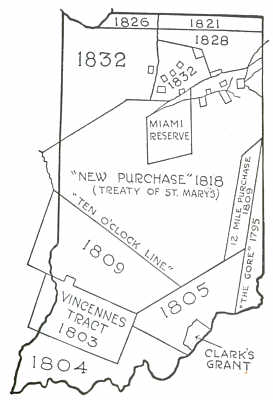
Purchase of Indian Lands
Image from "Early Settlers Along the Wabash" by Sandford C. Cox (1860)
Photographic reproduction of the book by Buckskin Press, 1972
In March, 1842 the Wyandot ceded all their lands in Ohio and Michigan and agreed to move to Kansas where they were to receive a new reserve of 148,000 acres. In July, 1845, 664 Wyandot left for Ohio by steamboat from Cincinnati starting the trek west to Kansas.
Most of the Miami managed to stay in Indiana until 1846 when 600 of them left for Kansas. Between 1865 and 1867 the Illinois, Miami, Piankashaw and Wea in Kansas were moved to northeast Oklahoma. The descendants of the Miami who stayed in Indiana still live in their original homeland in the north of the state.
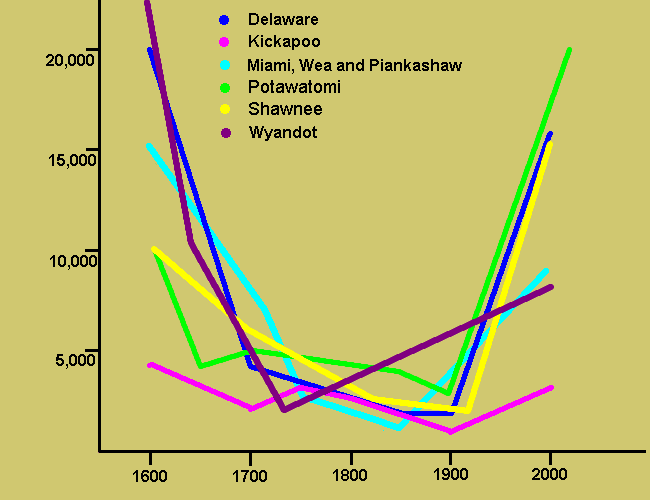
Native American populations
The graph was prepared with data from several sources, and should be viewed as an approximation.
When compiling this I used the figures given for all the people of a given tribe, no matter where they live.
When I was drawing these graphs I was struck by the steepness of the curves both in population decline and recovery. Here are my thoughts on this. All the figures, can at best, be a bit vague as I've used several sources for them, and some of the sources were vague to start with. This is especially true of the early figures, the early European and American explorers could not have come up with accurate numbers. The period up to 1850 saw great changes in the Native American populations. War, famine and disease had killed many and by then, especially at the end of the period, the tribes were scattered half way across the Continent. Many of mixed blood (for want of a better phrase) would have found life easier not to be identified as Native Americans. As well as this members from various tribes were absorbed into others. After around 1900, a great deal of the persecution had stopped and as life became more settled the populations would have started to increase, not only that, but more people of mixed blood would be willing to be counted as Native Americans.
In February 2005, I was reading a book, "Man and Microbes" by Arno Karlen (Putnam Books, 1995) which suggests that the reason the American Indian population, as well as those of other non-Old World indigenous peoples, such as those of Africa, Australia, the Arctic and the Indies declined so rapidly was because of the mere contact with the new comers from Europe and other places. Most of the following is taken from Chapter 7 of the book - "The Deadliest Weapon"
Simply put, the theme of the book is that germs, which include bacteria, viruses, fungi, and protozoa, live in a type of equilibrium with their "victims", including man. If a germ manages to kill it's victim, it is effectively committing suicide, so they manage to live with each other. It's only when that population's circumstances change through new conditions such as over-crowding, war, change in diet or even clothing, that problems arise. When a germ in introduced into a new population, such as bubonic plague into Europe from the Middle East or cholera from India, that because the population has no immunity to it, widespread death and illness occurs. This is what happened when the Old world met the New.
Unwittingly, strains of smallpox, measles, mumps, typhoid, typhus, influenza, diphtheria and scarlet fever, to which indigenous people had little or no immunity, were introduced. It also worked the other way round, during the first winter at Jamestown half of the settlers died through hunger and diseases to which they had little or no immunity. All through the 17th century, around 20% of settlers died because of germs to which they had no defense.
The death toll to the American Indian was devastating. People escaping religious persecution in Europe saw it as God's will that the native population should just die off. To be fair, there was little that could be done, even if the will was there, but some of what was written seems very unchristian like. In 1630, Increase Mather, Boston minister, first President of Harvard College and father of Cotton Mather wrote that,
"God ended the controversy [with quarrelsome Indians] by sending the smallpox among the Indians of Saugast, who before that time were exceedingly numerous. Whole towns of them were swept away, in some not so much as one soul escaping the destruction."
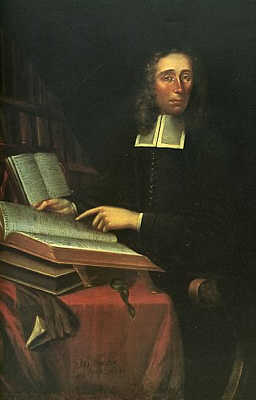
Increase Mather (1639 - 1723)
by John van der Spiett, 1688
from University of Virginia, Salem Witch Trials
In 1634, John Winthrop. first governor of the Massachusetts Bay Colony said that "the Lord hath cleared our title to what we possess."
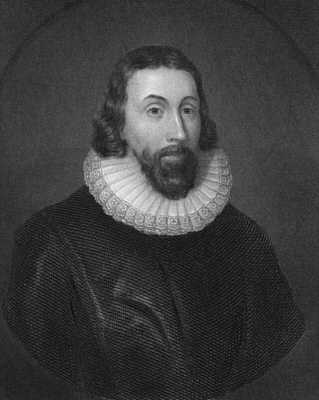
John Winthrop (1587 - 1649)
from Bible and History,Mrs. Anne Hutchinson
He was speaking of the smallpox epidemic that had earlier depopulated entire Algonquin towns and of which William Bradford, governor of the Plymouth Colony left this vivid account of...
"This spring, also, those Indians that lived about their trading house there fell sick of the small pox, and died most miserably; for a sorer disease cannot befall them; they fear it more than the plague; for usually they that have this disease have them in abundance, and for wants of bedding and lining and other helps they fall into a lamentable condition as they lie on their hard mats; the pox breaking the mattering, and running into one another, their skin cleaving (by reason thereof) to the mats they lie on; when they turn them, a whole side will flea off at once . . . and they will be all of a gore blood, most fearful to behold; and they being very sore, what with cold and other distempers, they die like rotten sheep . . . they were in the end not able to help one another; no, not to make a fire, not to fetch a little water to drink, nor any to bury the dead. . . . The chief Sachem himself now died, and almost all his friends and kindred. But by the marvelous goodness and providence of God not one of the English was so much as sick, or in the least measure tainted with this disease."
Here's some figures from "Man and Microbes" that show the death toll amongst various groups of American Indians...
1550- 1600, 80% of the population of the lower Mississippi valley - this ended the Mound Builder's civilization
1645, 50% of Hurons who could no longer defend themselves from the Iroquois and so had to leave their land
1684, 50% of the Iroquois
1738, 50% of the Cherokees around Charleston
1800's, two thirds of the Omahas
1837 - 1838, the Mandans were practically wiped out.
Altogether, Karlen says, up to 90% of the drop in population of American Indian societies can be blamed on disease. It took 400 years for these people to build up anything like a natural immunity, which incidentally, roughly agrees with the the very unscientific graph that I made.
Websites
American Indian tribe sites
Delaware / Lenape
Catholic Encyclopedia
Delaware Indian
The Delaware Indians
Delaware Tribe of Indians
Linape/ Delaware History Site
First Nations
Native Languages
Ohio History Central
Kickapoo
Catholic Encyclopedia
Culture
Electric Library
First Nations
Native Languages
Miami
Catholic Encyclopedia
Culture
First Nations
Little Turtle
Miami Nation
Miami Nation of Indians of the State of Indiana
Miami Tribe of Oklahoma
Native Languages
Ohio History Central
Mingo
Mingo Indians
Ohio History Central
Ottawa
First Nations
Ohio History Central
Piankashaw
Anthropological Report on the Piankashaw Indians at the Glenn A. Black Laboratory of Archaeology
Potawatomi
Catholic Encyclopedia
Citizen Potawatomi Nation
Community Environmental Profile
Culture
First Nations
Geographic Location of Potawatomi Bands: 1795-1846
at the Glenn A. Black Laboratory of Archaeology
Native Americans of Marshall County, Indiana
Native Languages
Ohio History Central
Potawatomi Trails Pow-Wow Committee
Potawatomi Web
Prairie Band Potawatomi Nation
Shawnee
Culture
First Nations
Native Languages
Ohio History Central
Shawnee's Reservation
Wea
Ohio History Central
Treaty with the Wea, 1818
Wea Tribe of Indiana
Wyandot / Huron
Allied to the French
Catholic Encyclopedia
Culture
First Nations
Ohio History Central
Paul's World
Quindaro
Spring Arbor
Wyandot Nation of Kansas
Wyandotte Nation of Oklahoma
General American Indian sites
About Specific Tribal or Nation Resources
American Indian Histories at Manataka
American Issues Index at First Nations
Battle of Tippecanoe
Culture - Native American
First Nations Histories
Indiana Indians
Indians of Northern Indiana
Indian Tribe Names at Running Deer's Longhouse
Map of American Indian Tribes at Running Deer's
Longhouse
Miami Documents at the Glenn A. Black Laboratory of Archaeology
Native American Culture at Great Dreams
Native Languages of the Americas
Photographs 1890 to 1930 at The Curtis Collection
Treaties between the US and Native Americans at
The Avalon Project at Yale Law School
Tribal Names at On This Date by Phil Konstantin
Tribes at Native American Indian History
General American History Sites
An Outline of Early American history at Hypertext on
American History This page created 13th January 2002, last modified 11th February 2006